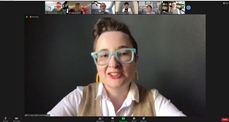
Dr. Casey Sigmon on Drawing Closer to God Through Online Worship
Just like many faith communities around the world, Saint Paul School of Theology now offers weekly chapel services online via Zoom. The obvious advantage is that it lets us gather safely for worship during a global pandemic.
But it’s equally important to recognize how these technologies actually enhance preaching and worship.
“At the heart of the matter, worship is worship,” says Dr. Casey Sigmon, Assistant Professor of Preaching and Worship and Director of Contextual Education. “We gather together by the power of the Holy Spirit (She is not limited by our present remote circumstance) to worship God revealed through Jesus Christ in prayer, song, and Word.”
Encountering God Together in the Virtual Space
The greatest gift of online worship, Sigmon says, has been the capacity to gather for worship as one body, even though we are scattered across most of the Midwest.
Chapel usually is held in two spaces: on the campus of OCU in Oklahoma City and Church of the Resurrection in Kansas City. Our growing remote population only had the chance to worship with other colleagues during Focus week.
But now, we all get to gather together! For Sigmon, a highlight each week is passing the peace in Zoom breakout rooms, along with answering a prompt related to the sermon. It’s a special time for connecting with staff, students, faculty, alumni and board members during worship.
Leaning into Collaboration
At Saint Paul, our guest music director for the fall semester is Hannah Rand. She is a member of The Many, a wonderful group of artists writing and composing songs of justice and hope. She also lives in Chicago and would not be able to lead us every week if we were worshiping in pre-pandemic ways.
The intentional use of digital technology, Sigmon points out, lets everyone fully participate, no matter where they may be located. There is joy in seeing and hearing one another as we gather in new ways to worship God. Tools like Dropbox and Google Drive enable the roles of worship to be shared. Youth can still bring in the light, members can still offer a call to Worship and so on.
Curation and Sharing
While pastors face a lot of pressure to create everything from scratch, social media is all about shared creations. That’s the beauty of curation, which means sharing art, words or testimonies that bring us closer to God.
Sigmon illustrates many wonderful ways to curate a holistic worship experience through social media. Is there a song you want folks to have in their mind before worship starts? Share it on media. An image you want to them to see? Post it! A podcast that helped shape your sermon? Share!
If we view social media platforms as spaces for shifting the conversation and theologizing reality, then we can curate holy and beautiful worship spaces on those platforms.
Fostering Creativity
For centuries, faith leaders have embraced media innovations as a means of sharing God’s love in new and engaging ways.
Martin Luther created worship experiences innovatively as print culture grew in dominance during the Reformation. Pastors today are doing likewise as we shift from print culture to our ever-evolving digital culture.
With today’s emerging technologies, we can plug and play pieces from our usual scripts. If we choose, we can also create a new multimedia, collaborative experience of worship. New platforms teach us new and creative ways to communicate in a culture that is coming into shape in the social media world.
Breaking the Fourth Wall
What this means, Sigmon tell us, is that worship leaders are able to break worship out of the building that we are used to thinking of as “church.”
Even in the pre-pandemic world, digital media was already reaching people who were physically unable to come to the sanctuary. It also provides a non-threatening way for those who are skeptical but curious to hear the Gospel and see what Christians are up to.
Virtual chapel can remind us that we are not just worshiping whenever we “go to church,” but, rather, that our lives are worship! If we lean into online worship design knowing we are reaching into the homes of our congregants, worship can move us beyond Western notions of consumer spirituality – I drive somewhere to get something out of church — and into a participatory model of co-creating the worship experience together.
Sigmon hopes that even when we return to the church building, ministers will continue to remind congregants of the gift of worship and discipleship at home. Our homes can be places where we encounter God, and the kitchen table offers a communal space for asking questions about the sermon.
Working Through Challenges
Sigmon misses two aspects of worship in particular during this time: congregational singing and communion.
She laments that technology does not yet allow us to reproduce that experience of hearing spontaneous harmonies and being uplifted by the song of a neighbor. “I do love hearing Hannah, and I tolerate the sound of my own voice, but I miss that aspect of the liturgy,” she says.
As a member of the Christian Church (Disciples of Christ), Sigmon participates in holy communion every Sunday with her family. At Saint Paul, however, participants have diverse theological understandings about the orthopraxy of virtual communion. For that reason, congregants have not shared communion during Zoom worship. However, Rev. Rodney Newman in Oklahoma City and Dean Margaretta Narcisse in Kansas City celebrate communion once a month on their respective campuses.
One more challenge Sigmon points to revolves around burnout. Many pastors feel burned out from months of learning a whole new framework so that they can continue to do what God has called them to do. And it’s not easy to learn how best to use all of the digital technologies!
There is also burnout for the laity who are weary of living all of social and work life online. The fatigue is real! Sigmon suggests empowering disciples to disconnect as well. Participants should be encouraged to listen to birds and cicadas outside, to be still and know that God is God and with us wherever we are.
Hands-On Experience in the Virtual Classroom
When Saint Paul went all online last Spring, Sigmon says the only thing that changed in her preaching class was “how we preach in the lab.”
Students were able to try out preaching in the online format and problem solve together as a group. They worked on skills such as good embodiment, pacing and eye contact online.
The same experience is now woven into Summer and Fall worship classes. Students are collaborating to design online worship for their final project. It’s a chance to work out the challenge of intentional worship design online for the sake of best practice in the church.
Students recently examined historical debates around the real presence of Christ in the eucharist and applied it to debates around virtual communion. Everything, Sigmon notes, is hands-on learning and discerning, even in a “virtual” setting. “We are living history right now, and are theologians on the ground as we live through revolution!”
Saint Paul encourages worshipers to join us for fall chapel on Mondays from 11 to 11:45 a.m. on Zoom. You can access recordings of previous services on our YouTube channel and through our Facebook page.
To learn more about how you can participate in virtual worship, contact Dr. Sigmon at .

Excellent thoughts. Thanks for sharing.